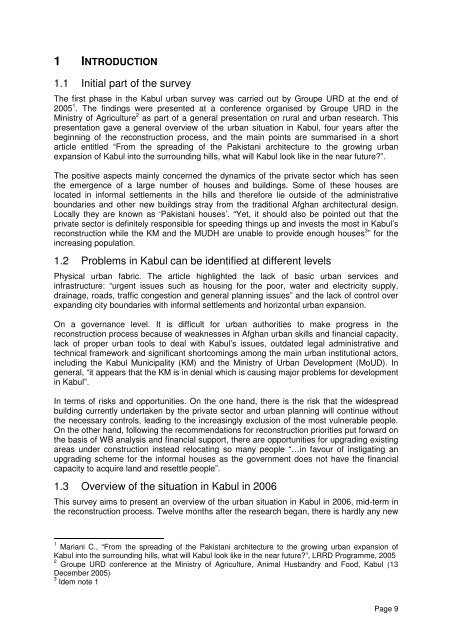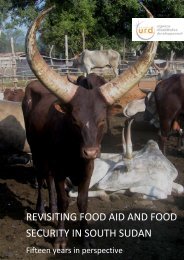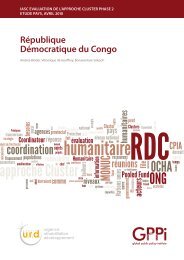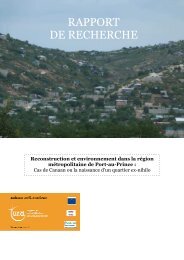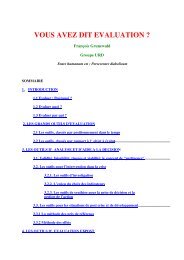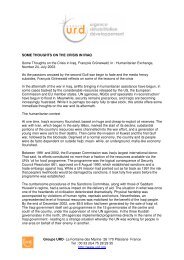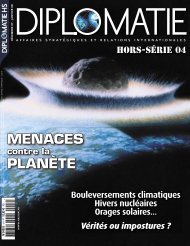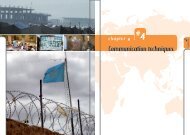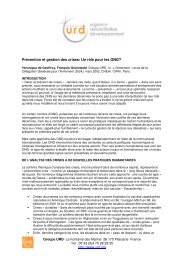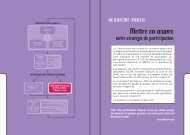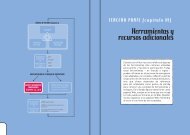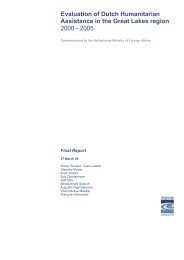Kabul Urban Survey - Groupe URD
Kabul Urban Survey - Groupe URD
Kabul Urban Survey - Groupe URD
Create successful ePaper yourself
Turn your PDF publications into a flip-book with our unique Google optimized e-Paper software.
1 INTRODUCTION<br />
1.1 Initial part of the survey<br />
The first phase in the <strong>Kabul</strong> urban survey was carried out by <strong>Groupe</strong> <strong>URD</strong> at the end of<br />
2005 1 . The findings were presented at a conference organised by <strong>Groupe</strong> <strong>URD</strong> in the<br />
Ministry of Agriculture 2 as part of a general presentation on rural and urban research. This<br />
presentation gave a general overview of the urban situation in <strong>Kabul</strong>, four years after the<br />
beginning of the reconstruction process, and the main points are summarised in a short<br />
article entitled “From the spreading of the Pakistani architecture to the growing urban<br />
expansion of <strong>Kabul</strong> into the surrounding hills, what will <strong>Kabul</strong> look like in the near future?”.<br />
The positive aspects mainly concerned the dynamics of the private sector which has seen<br />
the emergence of a large number of houses and buildings. Some of these houses are<br />
located in informal settlements in the hills and therefore lie outside of the administrative<br />
boundaries and other new buildings stray from the traditional Afghan architectural design.<br />
Locally they are known as ‘Pakistani houses’. “Yet, it should also be pointed out that the<br />
private sector is definitely responsible for speeding things up and invests the most in <strong>Kabul</strong>’s<br />
reconstruction while the KM and the MUDH are unable to provide enough houses 3 ” for the<br />
increasing population.<br />
1.2 Problems in <strong>Kabul</strong> can be identified at different levels<br />
Physical urban fabric. The article highlighted the lack of basic urban services and<br />
infrastructure: “urgent issues such as housing for the poor, water and electricity supply,<br />
drainage, roads, traffic congestion and general planning issues” and the lack of control over<br />
expanding city boundaries with informal settlements and horizontal urban expansion.<br />
On a governance level. It is difficult for urban authorities to make progress in the<br />
reconstruction process because of weaknesses in Afghan urban skills and financial capacity,<br />
lack of proper urban tools to deal with <strong>Kabul</strong>’s issues, outdated legal administrative and<br />
technical framework and significant shortcomings among the main urban institutional actors,<br />
including the <strong>Kabul</strong> Municipality (KM) and the Ministry of <strong>Urban</strong> Development (MoUD). In<br />
general, “it appears that the KM is in denial which is causing major problems for development<br />
in <strong>Kabul</strong>”.<br />
In terms of risks and opportunities. On the one hand, there is the risk that the widespread<br />
building currently undertaken by the private sector and urban planning will continue without<br />
the necessary controls, leading to the increasingly exclusion of the most vulnerable people.<br />
On the other hand, following the recommendations for reconstruction priorities put forward on<br />
the basis of WB analysis and financial support, there are opportunities for upgrading existing<br />
areas under construction instead relocating so many people “…in favour of instigating an<br />
upgrading scheme for the informal houses as the government does not have the financial<br />
capacity to acquire land and resettle people”.<br />
1.3 Overview of the situation in <strong>Kabul</strong> in 2006<br />
This survey aims to present an overview of the urban situation in <strong>Kabul</strong> in 2006, mid-term in<br />
the reconstruction process. Twelve months after the research began, there is hardly any new<br />
1 Mariani C., “From the spreading of the Pakistani architecture to the growing urban expansion of<br />
<strong>Kabul</strong> into the surrounding hills, what will <strong>Kabul</strong> look like in the near future?”, LRRD Programme, 2005<br />
2 <strong>Groupe</strong> <strong>URD</strong> conference at the Ministry of Agriculture, Animal Husbandry and Food, <strong>Kabul</strong> (13<br />
December 2005)<br />
3 Idem note 1<br />
Page 9


